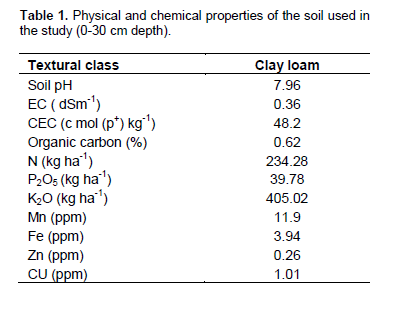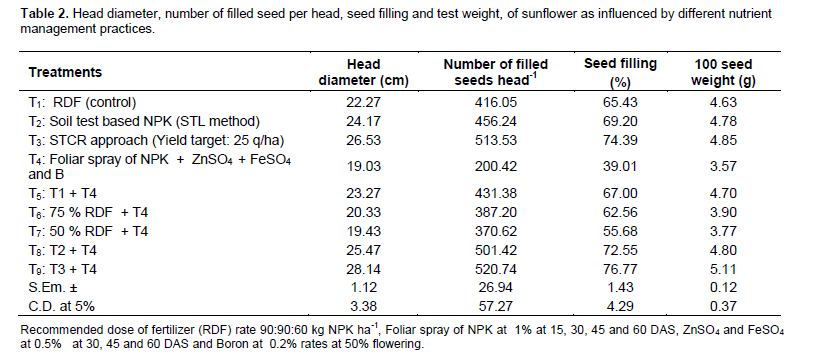Sunflower (Helianthus annuus L.) is an important oilseed crop fourth next to soybean, groundnut and rape seed in total production of oilseeds of the world. Now a day, the crop has been well accepted by the farming community because of its desirable attributes such as its short duration, photoperiod insensitivity, adaptability to wide range of soil and climatic conditions, drought tolerance, lower seed rate, higher seed multiplication ratio and high quality of edible oil. Recently sunflower has moved to northern parts of the country where the productivity is very high. Karnataka is the leading sunflower producing state in the country and contributes nearly 52% of the total area and 40% of the total production in the country. In India, sunflower is grown over an area of 0.83 million ha with a production and productivity of 0.54 million tonnes and 655 kg per ha, respectively during the year of 2012 to 2013 (Anonymous, 2013).
Among the various factors affecting the growth and yield of sunflower, nutrient management practices play a vital role. Presently, the chemical fertilizers are used as a major source of nutrients. But escalating cost, coupled with increasing demand for chemical fertilizers and depleting soil health necessitates the safe and efficient method of nutrient application. Some practices gaining much popularity to enhance and maintain soil fertility and reduce the continuous and over dose use of inorganic fertilizer application which may adversely affect the physico–chemical properties of soil and thereby affect the crop performance. The effective fertilizer recommendation should consider crop needs and nutrients already available in the soil. Among various methods of fertilizer recommendation such as general recommended dose (GRD), soil test based recommendation, critical value approach, etc., the soil test crop response (STCR) approach for target yield is unique in indicating both soil test based fertilizer dose and the level of yield that can be achieved with good agronomic practices (Singh et al., 2005). The objective of this study was to investigate the effect of fertilizer prescriptions by different approaches on quality and yield production of sunflower.
The field experiment was carried out in 2013-2014 rainy season at Main Agriculture Research Station (MARS), University of Agricultural Sciences, Raichur, Karnataka, India. Geographically the experiment place is located in North Eastern Dry Zone (Zone-2) of Karnataka State, which falls between 16° 15' N latitude and 77° 20' E longitude with an altitude of 389 m above mean sea level. The soil of the experimental site belongs to medium black with clay loam texture with pH 7.96.Other characteristics of the soil are given in (Table 1). Climate of Raichur region with the average maximum and minimum temperature is 33 and 21.5°C respectively and average rain fall of 62.72 mm.

Agronomic practices such as weeds, pests and diseases control except supplementary irrigation performed as recommended in the area and were done during growth season. Two seeds per hill were dibbled by maintaining 30 cm space between two hills in a row. To ensure even stand and to maintain required plant population, gap filling was done 13 days after sowing. Only one plant per hill was retained after thinning. Placement of solid fertilizer in the soil was applied as basal dose (half of nitrogen and full dose of phosphorus and potassium) was applied at the time of sowing and remaining half of nitrogen was applied at 30 DAS. NPK (19:19:19) was applied at 5 kg ha-1, Zn and Fe were applied in the form of ZnSO4 and FeSO4 at 2.5 kg ha-1 and finally Boron was applied at 1 kg ha-1 as foliar application according to the treatment details (T4, T5, T6, T7, T8 and T9). The soil analysis results reveals that available nitrogen was low, therefore addition of 12.5 kg ha-1 to the recommended level of nitrogen (90 kg ha-1) was done (103 kg ha-1) and medium in available phosphorous (90 kg ha-1) and potassium ( 60 kg ha-1) was applied for T2. The experiment has nine treatments, viz.
1. 100% Recommended dose fertilizer of NPK (T1),
2. Soil test based NPK (T2),
3. STCR approach (T3),
4. Foliar spray of nutrients NPK (19:19:19 at 1% spray at 15, 30, 45 and 60 DAS) + Zn (0.5 %) and Fe (0.5%) sprays at 30, 45 and 60 DAS + B (0.2%) sprays at 50% flowering (T4),
5. 100% RDF + Foliar spray of nutrients NPK, Zn, Fe and B (T5),
6. 75 % Recommended NPK + Foliar spray of nutrients NPK, Zn, Fe and B (T6),
7. 50% Recommended NPK + Foliar spray of nutrients NPK, Zn, Fe and B (T7),
8. Soil test based NPK+ Foliar spray of nutrients NPK, Zn, Fe and B (T8) and
9. STCR approach+ Foliar spray of nutrients NPK, Zn, Fe and B (T9).
The trial was laid out in a Randomized Complete Block Design (RCBD) with three replications. The targeted yield equations developed for the sunflower crop under AICRP on STCR scheme were used for the calculation of fertilizer N, P2O5 and K2O by considering the targeted yield of 25 q ha-1 was done by the equation listed below.
F.N. = 8.38 T- 0.57 SN (KMnO4 - N)
F.P2O5 = 8.05 T- 6.00 SP2O5 (Olsen’s - P2O5)
F.K2O = 9.87 T- 0.47 SK2O (NH4OAC - K2O)
Using the above fertilizer adjustment equations the quantity of fertilizer nutrients required for achieving 25 q ha-1 grain yield of sunflower was worked out. The fertilizer N, P2O5 and K2O applied for T3 was 96:165:57 kg ha-1.
Yield attributes
Different nutrient management practices have a significant effect on yield attributes, viz. head diameter (cm), number of filled seed head-1, seed filling (%) and 100-seed weight (g) (Table 2). Among the nutrient management treatments, it was significantly higher (28.14 cm, 520.74 and 76.77% and 5.11 g, respectively) under STCR approach + Foliar spray of NPK at 1% + ZnSO4 at 0.5% + FeSO4 at 0.5% and B at 0.2% (T9) than the rest of the treatments but statistically on par treatments T3 (STCR approach) and Soil test based NPK + Foliar spray of NPK at 1% + ZnSO4 at 0.5% + FeSO4 at 0.5% and B at 0.2% (T8) (Table 2). Similar results were reported for maize by Bakery et al. (2009). The positive effect on sunflower of foliar spray with micro and macro nutrients were observed by Barmaki et al. (2009), who revealed that the yield and yield components of sunflower were increased as a result of foliar spray with Fe, Zn and B. Significant increase in number of filled seeds per head and total number of seeds per head are increased with zinc and boron application. Similar type of synergetic effect was also reported on sunflower by Patil et al. (2006).

Seed and stover yield
Seed and Stover yield (kg ha-1) was significantly influenced by different nutrient management practices. According to the treatments T9 (STCR approach + Foliar spray of NPK at 1% + ZnSO4 at 0.5% + FeSO4 at 0.5% and B at 0.2%) recorded significantly higher(1919 and 2814 kg ha-1, respectively) was significantly higher yield recorded as compared to 100 per cent RDF (T1) and the rest of the treatments but statically it was on par (1860 and 2767 kg ha-1, respectively) with T3 (STCR approach) and T8: Soil test based NPK + Foliar spray of NPK at 1% + ZnSO4 at 0.5% + FeSO4 at 0.5% and B at 0.2% (1814 and 2719 kg ha-1, respectively) (Table 3). The results were in conformity with Kazem et al. (2013), who reported that the use of foliar spray on sunflower crop along with complete fertilizer increased grain yield significantly.
Aravinda et al. (2010) indicated that the response of sunflower to application of B, Fe or Zn was seen on the seed yield. The application of B (0.3%) significantly influence the seed yield, resulting of 983 kg ha-1 to 757 kg ha-1as is done on the control, increase of 226 kg ha-1 (23%) being provided as very significant statistically. It was attributed mainly due to proper seed filling as number of unfilled seeds was minimum in B (0.3%) treatment. The application of Zn or Fe also caused significant yield increase over control due to improvement in growth and yield attributes. Combined application of any two micronutrients could not increase the yield over single application of boron.
Oil content and oil yield
Different nutrient management practices were significantly influenced on the oil content (%) and oil yield (kg ha-1) of the sunflower crop. Treatment T9 (STCR approach + Foliar spray of NPK at 1% + ZnSO4 at 0.5% + FeSO4 at 0.5% and B at 0.2%) was significantly higher oil content and oil yield (38.53% and 739.58 kg ha-1, respectively) as compared to 100% RDF (T1) and the rest of the treatments but the oil content (%) was on par with T3 (STCR approach) and Soil test based NPK + Foliar spray of NPK at 1% + ZnSO4 at 0.5% + FeSO4 at 0.5% and B at 0.2% (T8) and oil yield (kg ha-1) was on par only with T3 (STCR approach). The lowest oil content and oil yield was recorded in treatment only with foliar spray of NPK at 1% + ZnSO4 at 0.5% + FeSO4 at 0.5% and B at 0.2 (T4) (Table 3). Foliar fertilization with balanced agrofond (N60 P60 K60) fertilized significantly influence on oil production due to sufficient amount of nutrient to fulfill the crop demand (Mihaela and Valeriu, 2010; Kazem et al., 2013).
The results of this experiments revealed that soil test based fertilizer application for desired yield targets with foliar spray of micronutrients significantly increased quality and yield production of sunflower crop. This positive effect may be due to their effects on root growth, nutrients uptake, simulation of many different enzymes related to photosynthesis, efficient response to plant nutrient requirement, integrated supply of nutrients from different sources and improved nutrient supply. The specific yield equation based on soil health will not only ensure sustainable crop production but will also steer the farmers towards economic use of costly fertilizer inputs.
The authors have not declared any conflict of interest.
The senior author is very much thankful to the Indian Council of Agricultural Research (ICAR) with collaborating India-Africa bilateral relation for providing scholarship to undertake Master’s degree program at University of Agricultural Sciences, Raichur (Karnataka State).